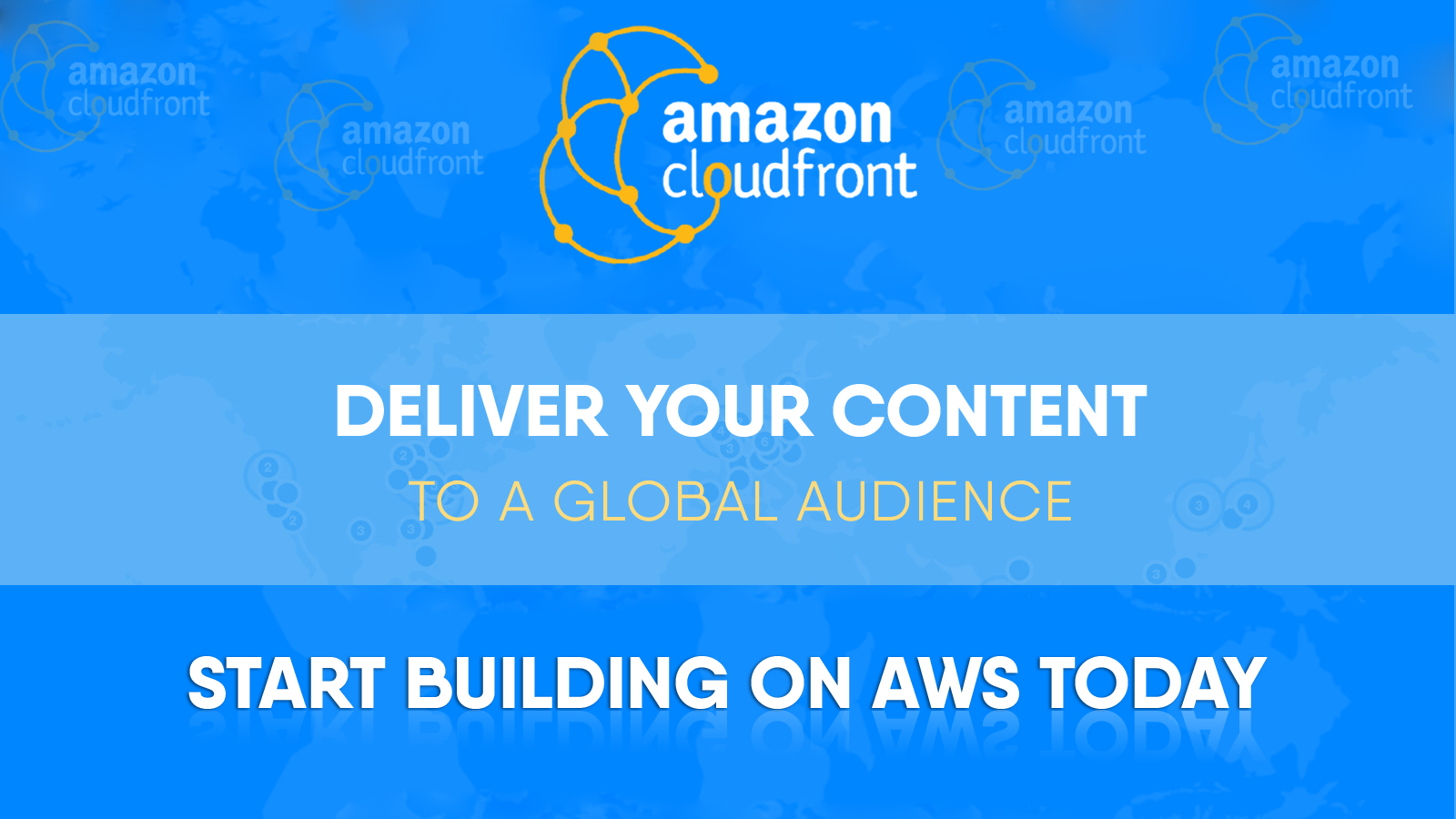The primary goal of a content delivery network or CDN is to deliver content from the providers like media companies to the audiences as quickly as possible. The model works by delivering content from the CDN server closest to the audience consuming it, thereby eliminating maximum number of network hops.
Key advantages of a CDN are:
- Offloads traffic served directly from the content provider
- Lower network latency, lower packet loss and higher availability
- Decreases server load for faster content delivery
- Manages denial of service attacks by absorbing some of the traffic
- Efficiently handles increased number of concurrent users
- More control of asset delivery
Amazon CloudFront is a global content delivery network service that securely delivers data, applications, videos and APIs to the audience with low latency and high transfer speeds. It uses a global network of edge locations and regional edge caches to ensure that your end-user requests are served by the closest edge location, thereby improving performance for the viewers. It supports all files that can be served over HTTP including static files that are a part of your web application and dynamic web pages such as HTML or PHP pages. CloudFront accelerates the delivery of dynamic content by moving it closer to the user to minimize internet hops involved in retrieving that content.
What has to be done to configure CloudFront?
- The first step is to define the server hosting the content you want CloudFront to deliver. The origin server can be an HTTP server or a S3 bucket.
- Next, upload your content (webpages, images, audios, videos, media files) to the origin server. Anything that can be served over HTTP or a supported version of Adobe RTMP can be made use of.
- Create a distribution through which you tell CloudFront what content is to be used and what to do with it. You can use either HTTP/HTTPS or RTMP Distribution. To create a distribution, create login for your Amazon AWS account, go to CloudFront control panel and select Create Distribution. When prompted for the delivery method, select Web. The defaults are usually sufficient for your application. A distribution draws its contents from an Origin which is where the CloudFront will draw files from should it not have a copy within the distribution.
- Select a web distribution for HTTP or HTTPS. In case your deployment uses RTMP protocols, choose an RTMP distribution.
- Create URL-matching rules for your distribution. Like, you can decide that a request including the string “/automobile/” fetches data from your HTTP server, while a request containing “/manufacturer/” should go to S3.
- Finally, use the domain name endpoint given to you by CloudFront as URL. It is through this URL that your users will be accessing your content.
Once the setup is ready, your Amazon CloudFront distribution is ready to serve requests. Your DNS service will route a request from your end user to the CloudFront endpoint URL, which will send it to the edge location that can serve the user’s request in best way.
Benefits of CloudFront for businesses:
Global content delivery network
The CDN is built on the expanding global AWS infrastructure with Edge locations delivering high availability, scalability and performance from anywhere in the world.
Programmable CDN
With Lambda@Edge, you can easily run your code across AWS locations worldwide. Upload your Node.js code to AWS Lambda and it will take care of everything required to replicate, route and scale your code with high availability.
Secure content at the Edge
The CDN provides both network and application level protection. Its infrastructure and processes are all compliant with PCI, DSS and ISO to ensure secure delivery of your sensitive data.
High performance
The CDN is optimized for low latency and high data transfer speeds. It makes use of AWS backbone network to accelerate the delivery of content end-to-end.
Deep integration with key AWS services
CloudFront is deeply integrated with and optimized to work with key AWS services including Lambda, S3, Elastic Load Balancing and EC2.
Key Features:
Dynamic and customized content
The CloudFront delivers all of your content, including dynamic one that changes for each and every user. You can configure multiple origin servers and cache behaviors on your website. Cache behavior is the set of rules you configure for a given URL pattern based on file extension, file name or any portion of a URL path on your website. The CDN allows you to configure multiple cache behaviors for your web distribution.
Security features
You configure the CloudFront to enforce end-to-end HTTPS connections from your viewer to your origin. You can securely serve private content by using signed URLs to restrict access to Amazon S3 bucket. Field-Level Encryption allows you to further encrypt sensitive data so that in can only be viewed by certain components and services in your origin infrastructure.
Reporting and analytics
CloudFront offers a variety of solutions for your different reporting needs. With CloudWatch, you can set alarms on operational metrics, learn about your end users and which domains referred them to your website.
Unified streaming
CloudFront can be used to deliver live video streaming and video on demand (VOD) without operating any media servers and building reliable, broadcast quality video workflows in the Cloud. CloudFront can be used to stream any live video origination service that outputs HTTP=based streams. It uses Adobe Flash Media Server 3.5 as the streaming server and streams your media files using Adobe’s Real-Time Messaging Protocol (RTMP).
Device detection
Amazon CloudFront can look at the value of User Agent header to detect the device type like desktop, laptop, mobile phone, smart TV etc. from where the end user request came. This information is passed to the Origin server in the form of new HTTP Headers that can be used to generate different versions of the content based on the new headers.
Cross origin resource sharing (CORS)
It defines a way for client web applications that are loaded in one domain to interact with resources of different domain.
Geo tagging
It can detect the country wherefrom your end users are accessing content, generating different versions for the users of different countries. CloudFront catches these versions at the edge location to serve subsequent users visiting your website from the same country.
Low TTLs
CloudFront uses the expiration period you set on your files to determine whether it needs to check the origin of an updated version of the file.
Custom SSL
This feature provides your website the security benefits of CloudFront over an SSL connection that uses your own domain name in addition to lower latency and higher reliability.
Query string parameters
This feature helps you customize your webpages for each viewer, leveraging the performance and scale the benefits offered by caching content at Amazon CloudFront edge locations.
Besides the more obvious features already discussed above, with Amazon CloudFront, one can:
- Enable AWS WAF (Web Application Firewall) to secure content
- Configure the default TTL and Max TTL values
- Add signed cookies for private content
- Since it is PCI DSS compliant, you can engage in multiple ecommerce activities
- Add support for advanced SSL features.
You need a content delivery network if:
- The number of website users is increasing
- Your audience is geographically distributed
- Your website’s media quality is poor
- Your website speed is slow and downtime is high
- You are in need of more storage or bandwidth
Use cases
Replacing S3
CloudFront has a global network of edge locations or data centers spread around the world. The user request is routed to the nearest edge location to achieve high performance delivery of the content. It allows for parallel downloads and improves the performance of your application.
Caching dynamically generated content
You can use CloudFront to replace custom caching solution and fine tune its behavior. CloudFront supports Etag headers used by the browsers to save bandwidth. Etags are a sort of a hash or a digest, of the given resource. Just add Etag to your content on CloudFront and this behavior will be automatically triggered.
Whole-site delivery
In the typical usage pattern, CloudFront acts as a CDN for static content only, typically hosted on S3 or on your custom Origin server. CloudFront can be used as a proxy for both S3 and EC2 instances, or your own Custom Origin server.
The CloudFront lets you quickly obtain the benefits of high performance content delivery. Developers benefit with tight integration with other Amazon Web Services. With Amazon S3, EC2 and Elastic Load Balancing as origin servers, it provides developers a powerful combination of durable storage and high performance delivery.
Low latency and high transfer speeds
As the cloud continues to dominate application and content delivery, AWS continues to dominate the cloud. There can’t be many providers who haven’t given a serious thought to migrating their operations to AWS cloud. Amazon CloudFront prides itself in securely delivering data, applications, videos and APIs to site users, with low latency and high transfer speeds. Websites using Amazon CloudFront benefit from AWS security and integration with AWS services. The service is useful for the companies that require higher response times and large file content. CloudFront is beneficial for a business developing a website that distributes a lot of content that needs to scale up.
You can contact Flexsin for your Amazon CloudFront setup and integration requirements. We have highly experienced developers to meet your CDN deployment needs.


 Jeet
Jeet


